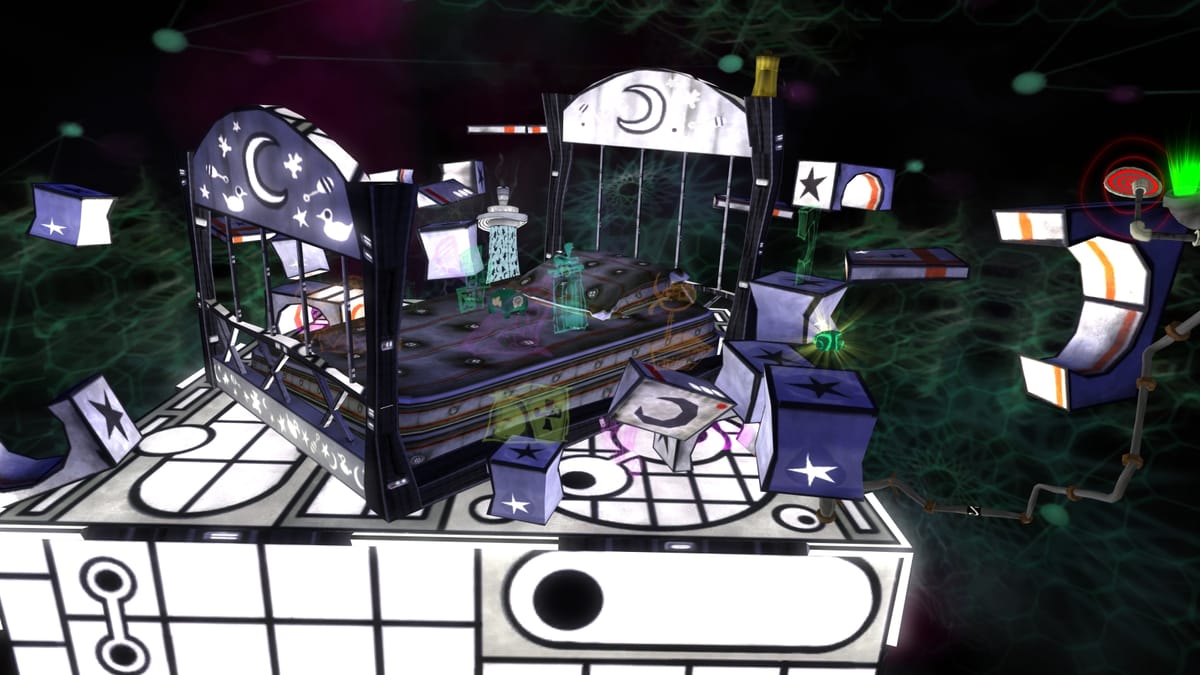
“The human mind… a three pound pile of dreams. The ultimate battlefield – the ultimate weapon. All wars of the psychic age are fought within these damp, curvaceous undulations. Paranormal paratroopers! Mental marines who are about to ship out on the adventure of their lives! This is our beachhead, and the brain is your landing craft. You shall engage the enemy in his own mentality–you shall chase his dreams, you shall fight his demons, you shall live his nightmares! And those of you who fight well, you will find yourselves on the path to becoming international secret agents– in other words… Psychonauts!
The rest of you… will die!”
Psychonauts (2005) opens with an impassioned speech (paraphrased above) by Psychonaut and Camp Whispering Rock Coach Morceau Oleander. It perfectly sets the tone for the adventure you’re about to embark upon, filled with humor and an eccentric cast of characters inhabiting odd locations. Developed by Double Fine Productions, Psychonauts is another one of my favorite games and pieces of media in general. With the sequel finally arriving sometime this year and the addition of the original to Xbox Game Pass, now is the perfect time to revisit this cult classic or experience it for the first time.
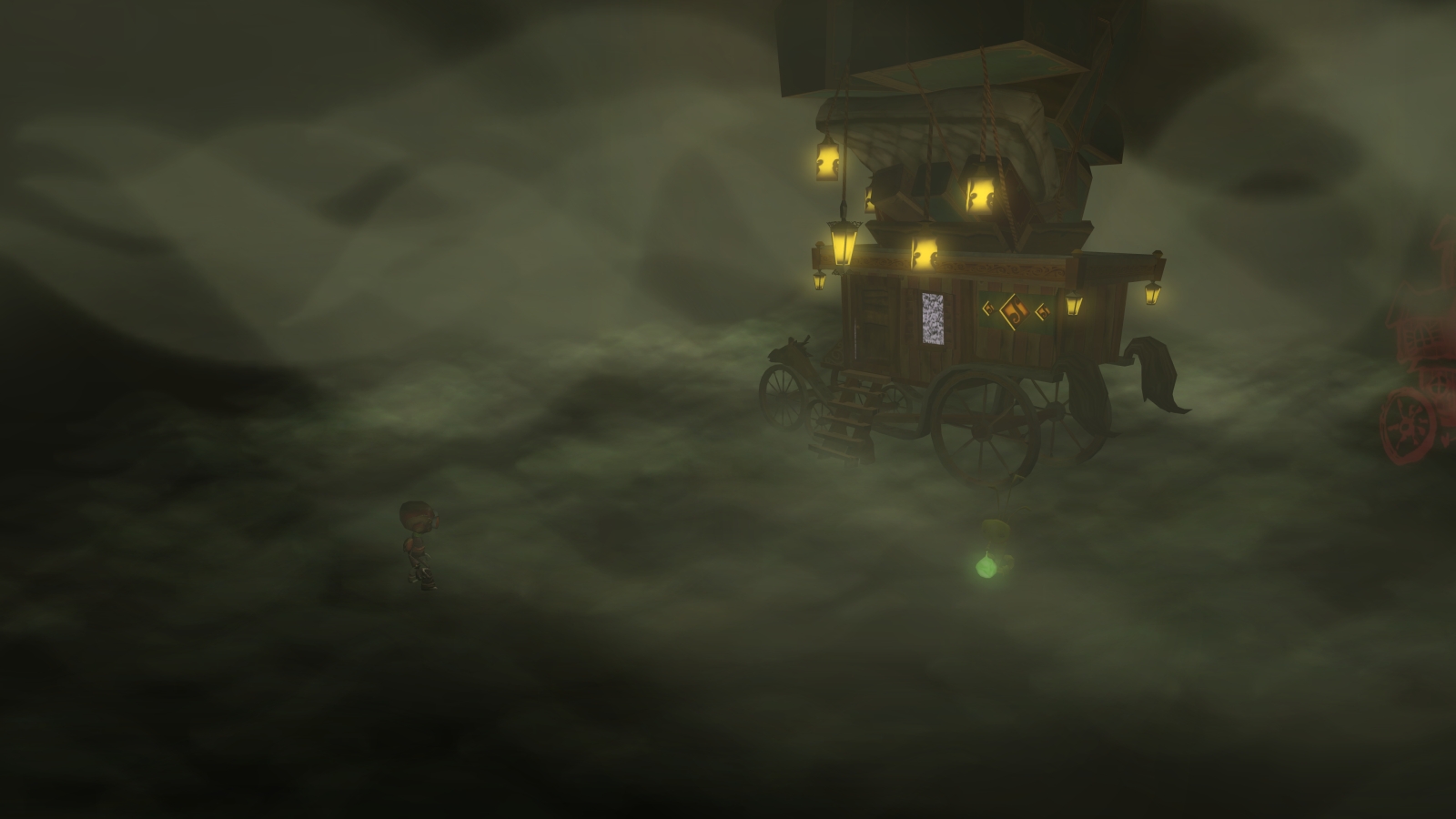
Full disclosure: I’ve pretty much been enamored with Double Fine ever since I first played Psychonauts way back when on the PS2 by borrowing it from a friend, then buying it on PC after I had to return it. Heck, I even bought the PSVR game BEFORE I even owned a headset. Working at Double Fine in any capacity is one of my dream jobs (if you’re reading this, DF hiring people, I’m pretty good at writing and puns) and while I’ve never heard anything back I’ll keep applying until I either get a job or they send me a cease and desist. So yeah, you could say I’m biased, but media criticism is hardly objective and you’re not my mom — unless you are, hi mom! Look, if you haven’t played Psychonauts before it’s pretty dang available nowadays, so before you read me gush about the game for 11 pages just go play the darn thing. It’s on Steam and PS4 for ten bucks and of course free with a Game Pass subscription or a free trial. It’s influenced my life and work about as much as Earthbound, Gravity Rush, or NieR, so I encourage you to form your own opinion before you punch your brain with mine, because I’m going to talk about the whole game, spoilers and all. Go on, I’ll wait.
If you followed my advice (if you didn’t, it’s OK, we can still be friends), you’d know that Psychonauts follows Razputin, or Raz, after running away from his home in the circus to become a Psychonaut at Whispering Rock Summer Camp. Since he didn’t actually get his parents’ permission though, his dad is coming to pick him up and take him home the next day. Raz has one day to cram a whole summer’s worth of psychic lessonsand fulfill his dream of becoming a Psychonaut. Even though he’s really not supposed to participate in any camp activities, Coach Oleander lets him into his mind with the rest of the kids for Basic Braining. It’s clear that Coach really believes in what he said at the beginning: his mind is a military themed obstacle course, complete with mines, planes, barbed wire, and cute little bunny soldiers.
Thankfully, with his circus upbringing and a little bit of psychic experimentation, Raz has everything he needs to get through in one piece. He can double jump, attack with psychic fists, balance on tightropes, and even do the trapeze. This first level is focused mostly on the platforming so you can get to grips with Raz’s abilities, and he feels great to control. Every move you make feels snappy, responsive, and just fast enough to give you a nice flow. Of course there are a few combat and puzzle solving sections here as well, like finding the secret passage to progress or figuring out how to avoid a turret’s gunfire, but for the most part this is simple and sweet platforming. Here you’re introduced to the multiple types of collectibles found in mindscapes; Figments, collecting 100 will increase your rank; Vaults, which give you slideshows of a person’s memories; and Mental Baggage, which you can sort by reuniting each literal bag with its accompanying tag. Once you reach the end of the course, Raz earns his Basic Braining merit badge and is free to explore the rest of the camp.
Whispering Rock is the game’s hub, and there’s a ton of stuff to do here. You start off by the kids cabins, but just outside of that is the main lodge and parking lot from which you can enter the woods or the lake. The area is an “Indian burial ground”… meaning Native Americans buried some of their stuff here, like arrowheads! Because the arrows are made of psytanium, the camp uses them as a currency in the main lodge’s shop, which is run by an elderly gentleman you’ll quickly grow familiar with as he seems to run literally everything around here. The shop sells crucial items like the dowsing rod, to find deeper, more valuable arrowheads, and the cobweb duster, which removes mental cobwebs. Around the camp, you can also find cards scattered about and some giant eyeballs with cards around them. Once you’ve discovered Agent Ford Cruller’s (the old man around camp) secret underground base, you can use his machines to convert mental cobwebs into a card, and a set of nine cards along with an eye from the camp store to create a full set and increase your rank by one. Increasing your rank will get you new powers, such as telekinesis, or upgrades to existing powers, like being able to throw things further with TK.
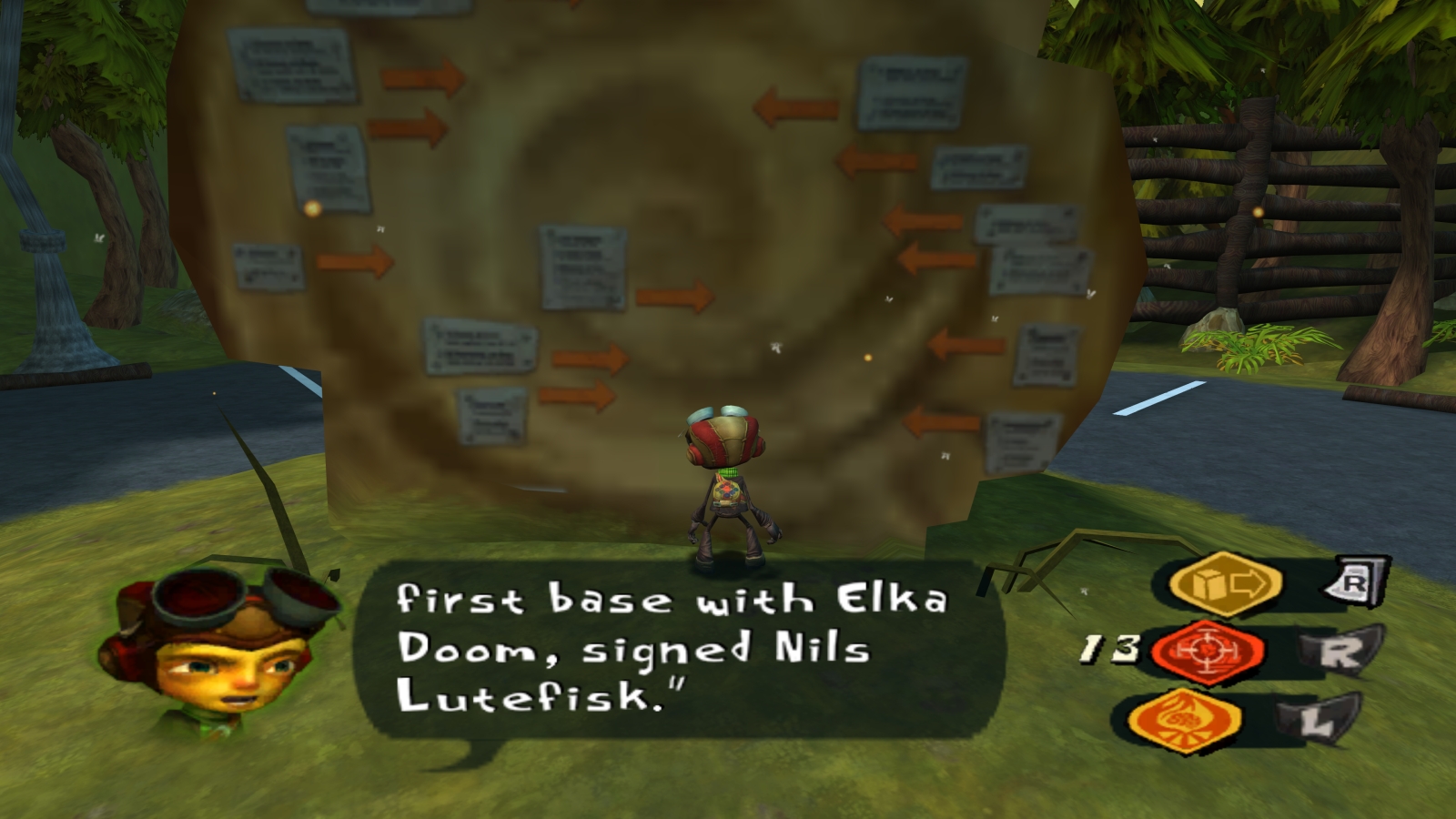
Once you’ve had your fill of exploring, Agent Nein has seen potential in Raz and asked him to come to his secret lab, which is hidden in the Geodesic Psychoisolation Chamber (don’t ask). You find his lab and agree to take part in his experiments within your own mind using the Brain Tumbler. Raz soon discovers that there are strange things within his mind, mostly meat. Oh and there’s a giant scary monster too. Unable to continue further because of the monster, Nein invites Raz into his much more orderly mindscape to learn a new ability: PSI-Blast. Raz is tasked with shooting 1000 Censors, creatures that stamp out things like intrusive thoughts, but things go awry when the kid tries to make his training go faster and spoils the tranquility of Nein’s cube-like inner world, letting loose a ton of Censors.
To get things back in order, Raz needs to close off all the pipes Censors are entering from using his PSI-Blast. This is a projectile power that uses the feeling of aggression as ammo, you assign it to a button (LB, RB, or RT) and press it to let loose a shot. Just standing there like an idiot isn’t going to help you hit your mark though, so you’ll want to target an enemy in a very Zelda-like fashion with LT before you shoot. You can find more ammo as well as pickups for your mental health (get it?) after defeating enemies or by destroying objects, because breaking stuff is fun. It works fairly well, but I do have some complaints when using this power. You can’t move while using it and the targeting can be a little finicky with distance sometimes. Some mental miscreants you’ll encounter can both hurt Raz from afar and pack quite a punch up close, so a lot of the time if I couldn’t target something from afar it was better just to go up and melee them than waste shots. With upgrades and the realization that you can shoot in the middle of a dodge it gets much better though, by the end I was able to hit around 6 enemies with a single blast.

Once you’ve closed off all Sasha Nein’s outlets, you realize that closing ALL of them was a bad thing, and a giant Censor emerges. This is the first boss fight and.. Well, Psychonauts isn’t really known for excellent boss battles. It’s not that they’re bad, they’re just not anything special unlike the rest of the game. Defeating the giant Censor is a simple task: just stop the normal Censors from healing it then blast it a few times and you’re done. Even if Psychonauts did the whole Mario Galaxy thing on Sasha’s cube brain two whole years before the latter released, this boss fight feels completely divorced from its context. The rest of the game is so great at tying the story and gameplay together that the few bosses you do fight feel like a big missed opportunity, especially since you learn so much about Censors here but hardly ever see them afterwards. Even just a little platforming or puzzle solving to spice things up would have been nice, or some more context involving Sasha’s childhood trauma that is clearly present throughout the level.
Regardless, once you get the merit badge for Marksmanship it’s back into the brain tumbler. Raz easily defeats the monster and, after a little more platforming or combat depending on which route you take, finds a creepy tower. While he can’t quite reach the top with his current abilities, he can see what appears to be a dentist removing another camper’s brain. To get up there and investigate, Raz needs the Levitation badge. Conveniently, Agent Milla Vodello is currently giving Levitation lesions down by the docks. On his way, Raz bumps into Lili and the two discover that there’s something weird going on in the Astral Plane… something to do with meat. They resolve to meet by the lake later that night to share their findings (and maybe make out, as Lili thinks). Milla’s class is on a dock in the middle of the lake and, unfortunately, Raz can’t swim. Well, it’s not that he can’t swim, but that years ago his family was cursed to die in water. Anyways, he can use one of the canoes to cross the lake after receiving his Orsman badge from Cruller, disguised as an admiral and pretending not to recognize him *wink*.
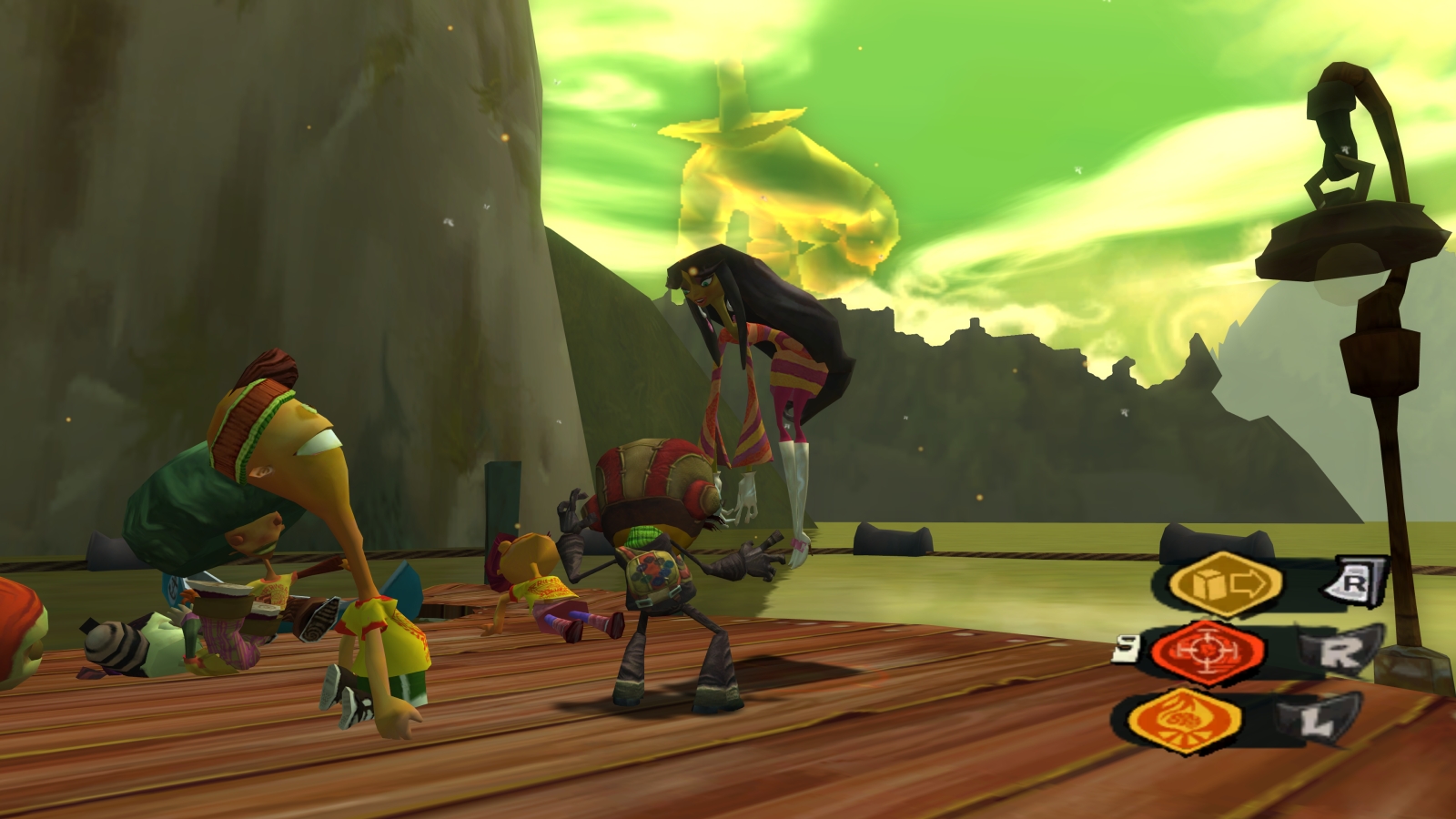
Despite her earlier protestations about Raz participating in camp activities, she quickly invites him to the psychedelic party in her mind with the other kids. This is another level focused on platforming, to a much greater extent than the Coach’s battlefield. The 60’s themed party is all about Levitation and the myriad of things the ability lets you do. Just like Marksmanship, it’s assigned to a button you choose and upon pressing it Raz hops on a psychic ball of energy. By rolling around the ball, you can move quite a bit faster, jump further and higher, and even float gently to the ground by holding LT in midair. This is by far my favorite ability in the game as it opens up many platforming possibilities and can even be used creatively to circumvent some obstacles. I also just like going fast.
To reach Milla at the end of the party zone(™), you have to progress through each room, activating rings by going through them with your Levitation power and thus opening doors or activating platforms. Thankfully, most of the moving platforms have barriers on them so you don’t fall off, and aside from gaining momentum in skate bowls, reaching the end of the obstacle course is pretty easy. After that, you and the rest of the cadets participate in a race down a huge track with several obstacles. Placing first is also pretty easy, but gathering Figments on the way down is magnitudes more difficult. I understand that, because of theming, they’re slightly transparent and use the color pallet of the current level, but this also has the effect of making them very difficult to spot in certain situations. I’ve 100% this game several times, and getting all the Figments in this level in particular is always a pain. Of course, you don’t have to get all the collectables to beat the game, or even most of them, but it’s worth noting for other completionists.
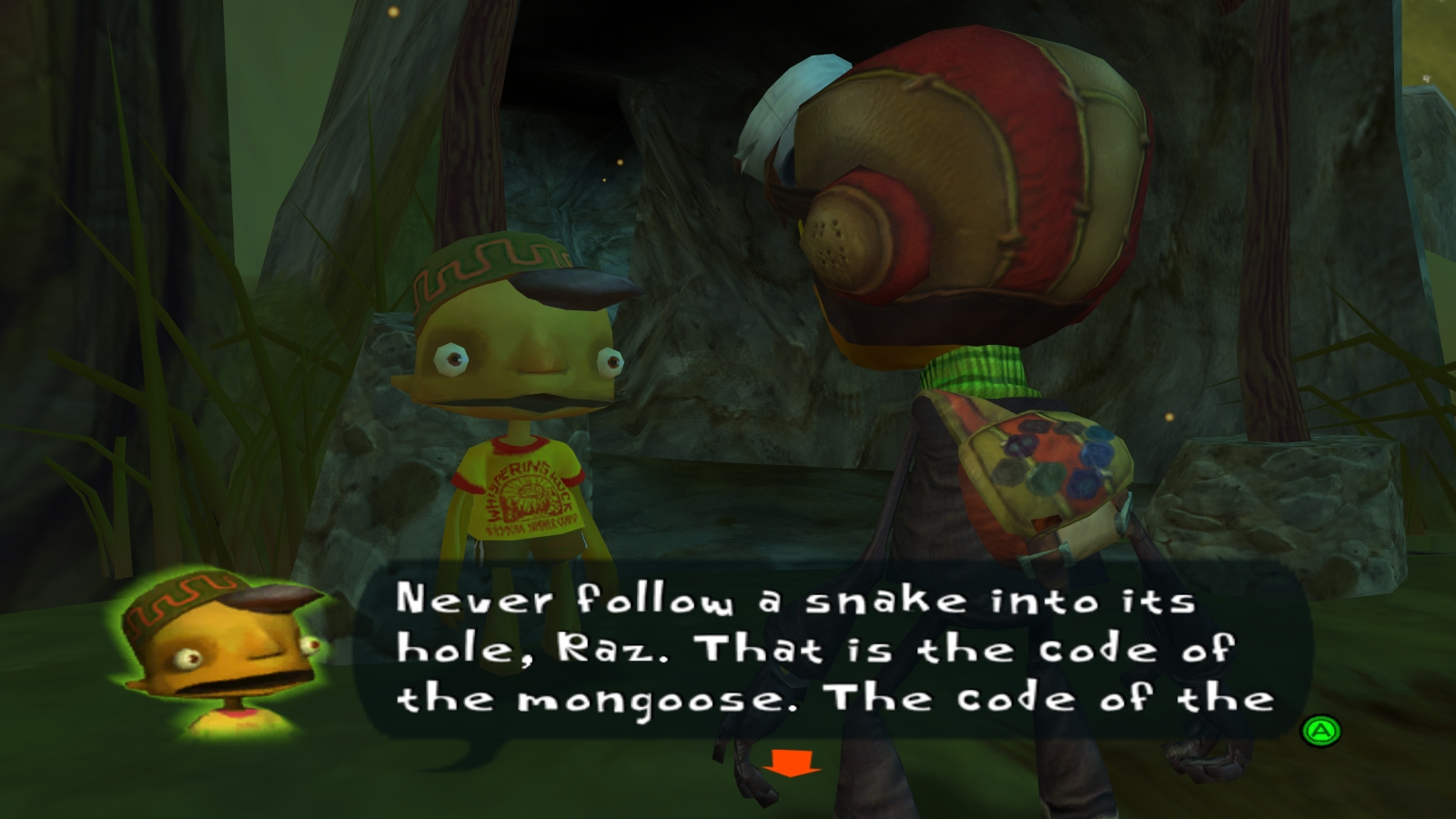
Competing Milla’s course will net you the Levitation badge for use in the real world, and before we head back to the brain tumbler let’s talk about two things: the art style and the characters. So after downloading the Game Pass version of Psychonauts, I was surprised to learn that it’s the exact same version that’s on Steam… that I already own. To that end, Psychonauts still looks distinctly of its era, textures are low resolution and animations can look weirdly stiff. Bumping the resolution up to the maximum possible didn’t really help much from a technical standpoint, but the game’s art direction is still so unique and striking I didn’t care about blurry textures or pre-rendered videos. With bright colors and a diverse cast of weirdly proportioned characters, Psychonauts achieves a cartoony aesthetic while always reminding you that something sinister lurks under the surface. That fun but creepy atmosphere carries over to the characters and is where a lot of the humor comes from. For example, it’s clear from the start that Raz is a very genuine and kind person but if, for example, you use Pyrokinesis on a few woodland creatures or seagulls he may randomly go from expressing remorse to cheerfully declaring “See you in Hell!” Another example are two of the campers, Clem and Crystal who are 10 and 9 years old respectively, appear to be extremely cheerful to an annoying extent. That is, until you find them drinking poison or standing on a roof looking over the edge talking about how they’re about to become unimaginably powerful. This dark sense of humor perfectly contrasts with the bright colors and the overall message of empathy to an absolutely hilarious extent. While I haven’t replayed the game in a while before this playthrough, even when I knew some jokes were coming I still laughed out loud. The sharpness and wit of the writing here is very rare.
Going into the brain tumbler himself, at the top of the tower he discovers that the mad dentist’s name is Doctor Loboto and he plans to use the kids’ brains to power psychic tanks and take over the world alongside Coach Oleander. Before he can tell Nein though, he leaves on urgent Psychonaut business. Razputin then heads back to the lake for his meeting with Lili, and discovers that, just like in his vision, Dogen is missing his brain. As Raz and Lili are talking, she’s suddenly kidnapped by a giant fish monster. Luckily, the camp has a bathysphere which Raz can use to safely enter the water and chase after the beast. Once under the lake, he fights and defeats the Lungfish only to discover that the creature was being mind controlled. Entering their mind begins another of my favorite levels in the game: Lungfishopolis.
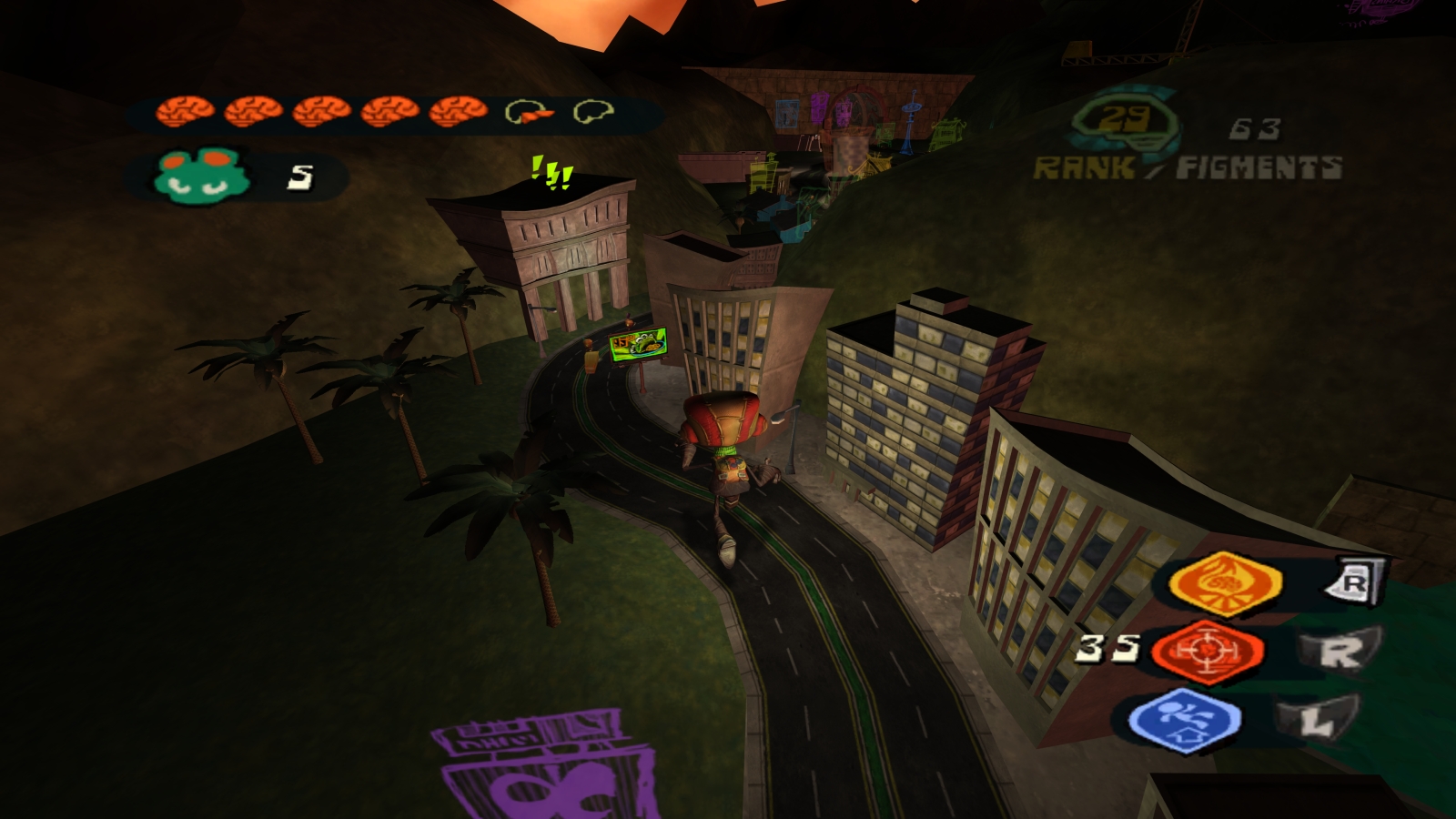
It’s weird to call Psychonauts’ first three levels “down to earth” or “standard” but compared to the rest of the game that’s basically what they are. Starting now, things are about to get wild. In Lungfishopolis, Raz is a giant – he can climb or destroy buildings just like Godzilla or King Kong. While most of the citizens will flee from the monster they’ve dubbed Goggalor, members of the resistance who are battling against the tyrannical Kochamara who’s using a tower to control the minds of the citizens try to recruit you to their cause. To get up to the tower though, you need some sort of platform to bounce on. There is a blimp in a part of the city, but you need to get through a tunnel filled with deadly lasers first. Destroying a prison where resistance members are being held rewards you with the Shield merit badge which is… one of the less useful abilities. It’s basically only useful in this level to destroy the laser tunnel by reflecting the lasers and to defeat the boss, but that’s about all it’s good for. You can’t move while shielding, so I find it’s better to just dodge things. It would have been cool to see this used for more puzzles in the game, or even as a defensive counterpart to Levitation, but maybe it’ll get more attention in the sequel.
Reaching the tower of Lungfishopolis, Raz is confronted by Kochamara, who is very clearly just Coach Oleander wearing a costume. The young psychonaut cadet handily defeats him in another bland boss fight, although hearing Coach call out all his attacks was pretty hilarious, and saves the city. The lungfish, who we discover is named Linda, drops Raz off at Thorney Towers Home for the Disturbed where Dr. Loboto and the childrens’ brains are. The gate is locked, however, and a man named Boyd is muttering to himself just outside. This is quite possibly the most iconic level of Psychonauts, next to Lungfishopolis, aptly titled… The Milkman Conspiracy! Most of the mental worlds so far have focused on platforming, combat, or just being really big, but The Milkman Conspiracy draws heavily from Lucasarts adventure games and is almost entirely puzzle solving.

The level begins in Boyd’s home, where he is still muttering to himself about milk, the milkman, and cookies. You can try to leave, but there’s no door. Speaking to Boyd, Raz will ask where the door is. Boyd will reply it’s on the front, like most refrigerators. Opening his refrigerator will reveal the Clairvoyance badge, one of the less practical but most fun badges. It allows you to see the world through other people’s eyes and is central to this level’s focus on puzzle solving. Using Clairvoyance on Boyd allows you to see the conspiracy theories floating around him, including the milkman’s plot to kill him. He asks Raz to find the truth about the milkman, and the door to his house appears.
The neighborhood you exit into is weird to say the least. The streets float in a teal void, curving around like a snake in space.There are strange men in trench coats everywhere, saying they are “working with the road crew” and “a grieving widow.” To blend in with them and progress through the level, you need to find and hold an item pertaining to their job to cross through their work zone marked by yellow lines. For example, you need a stop sign to join the road crew and a flower to be a grieving widow. It’s basically the adventure game mandate of taking everything that’s not nailed down and using everything on everything else. While this level is known for its humor, I think it’s one of the weakest in terms of gameplay. The problems mostly come with navigating the neighborhood – it’s gigantic, everything looks the same, and there’s no map. While this does add to the feeling of a neighborhood putting up a veneer of happy living, it’s extremely confusing and feels like it wastes a lot of your time. Since only some of the houses have important items in them, you end up entering every single one of them multiple times in an attempt to stumble back upon what you’re looking for. It’s frustrating to have solved a puzzle, only to have to spend five minutes trying to find the puzzle again. Furthermore, the inventory system was clearly not designed for this many items at once. Raz always carries the cobweb duster (which the game tells you you need for this level specifically), smelling salts for quick psychic exits, and a piece of raw bacon to summon Ford for advice. That’s three slots used up out of eight in the radial menu, and you get more than enough items here to fill up a full page. That means this is the only level in the entire game with two pages of inventory, which just makes navigating this menu awkward.
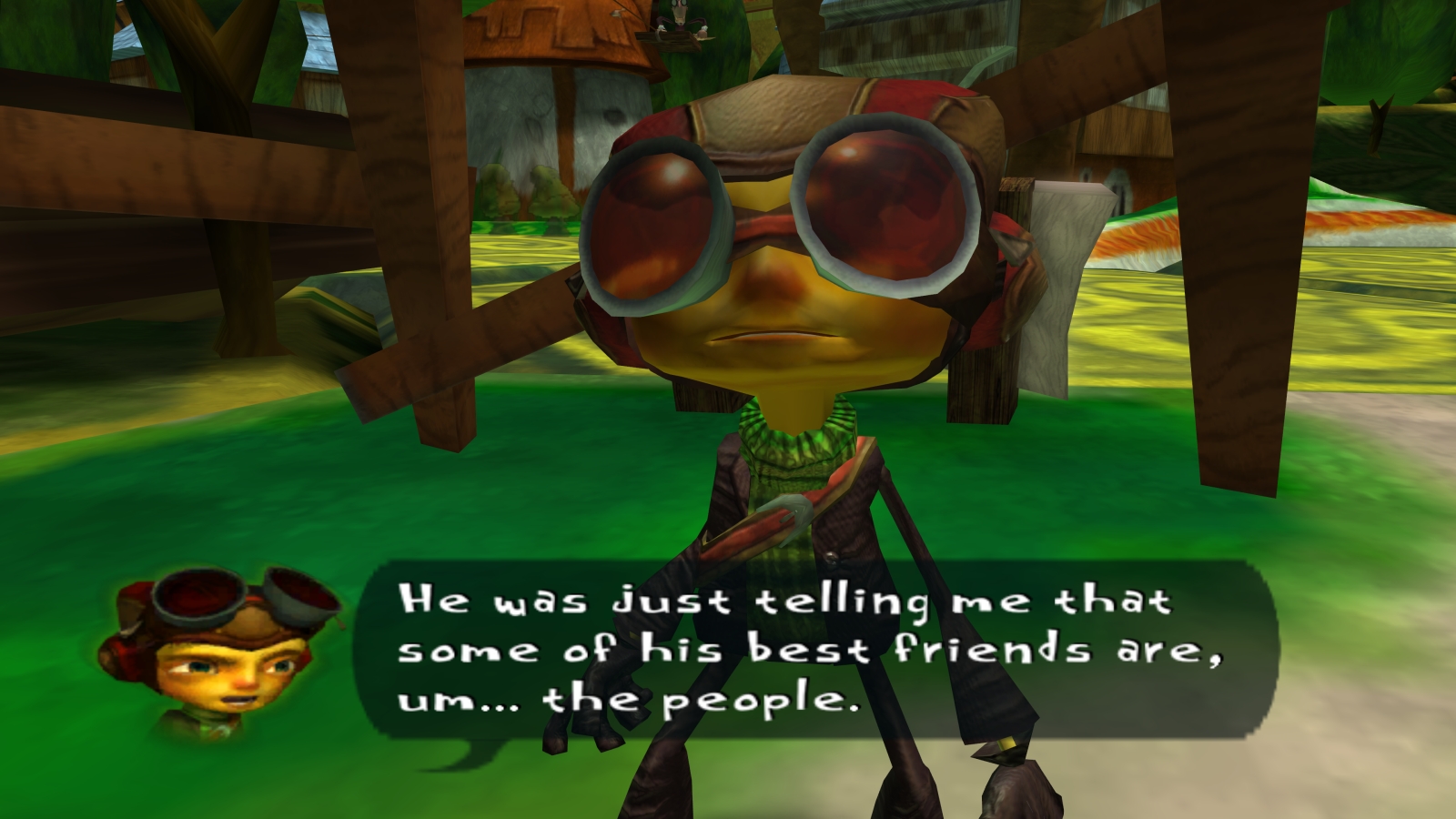
Aside from the inventory puzzles, there’s not much else going on in this level. After solving a few puzzles, occasionally you’ll get pulled into a miniboss arena where you need to TK some bombs into an enemy’s mouth. They’re pretty easy fights and break up the puzzle solving, but they don’t change as you progress so it gets tedious by the third and final time. Using Clairvoyance on the trenchcoats while holding an item will reveal that they see you as looking exactly like them, while the girl scouts that litter the neighborhood view you as a milk thief. It’s a really nice touch and carries over to the rest of the game when using the power on anyone else. For example, Ford will see Raz as a full-fledged psychonaut while Lili will see him as her knight in shining armor. It certainly encouraged me to break out the power every time I encountered someone I hadn’t used it on yet and can lead to some funny or heartwarming results.
Once you’ve solved all the puzzles, you finally make your way to the girl scouts base and find that they’re hiding the milkman in their underground basement. Raz fights and defeats the troop leader and awakens the milkman, who makes the streets run white with his rage. Because his milk is so delicious (and explody) Raz is kicked out of the astral plane. A slightly less crazed Boyd opens the gate and remembers why he’s here: to make his final special delivery of a milk moletove to the main building of the asylum. It doesn’t look like he’s going to actually throw the thing anytime soon though, so you can finally move further into the complex. Well, you could if there wasn’t an actress performing for some potted plants in the garden, stopping Raz if he tries to walk past because she thinks he’s here to steal her trophy. You know how this song and dance goes by now: Raz enters her mind to help her with her issues and hopefully proceed.
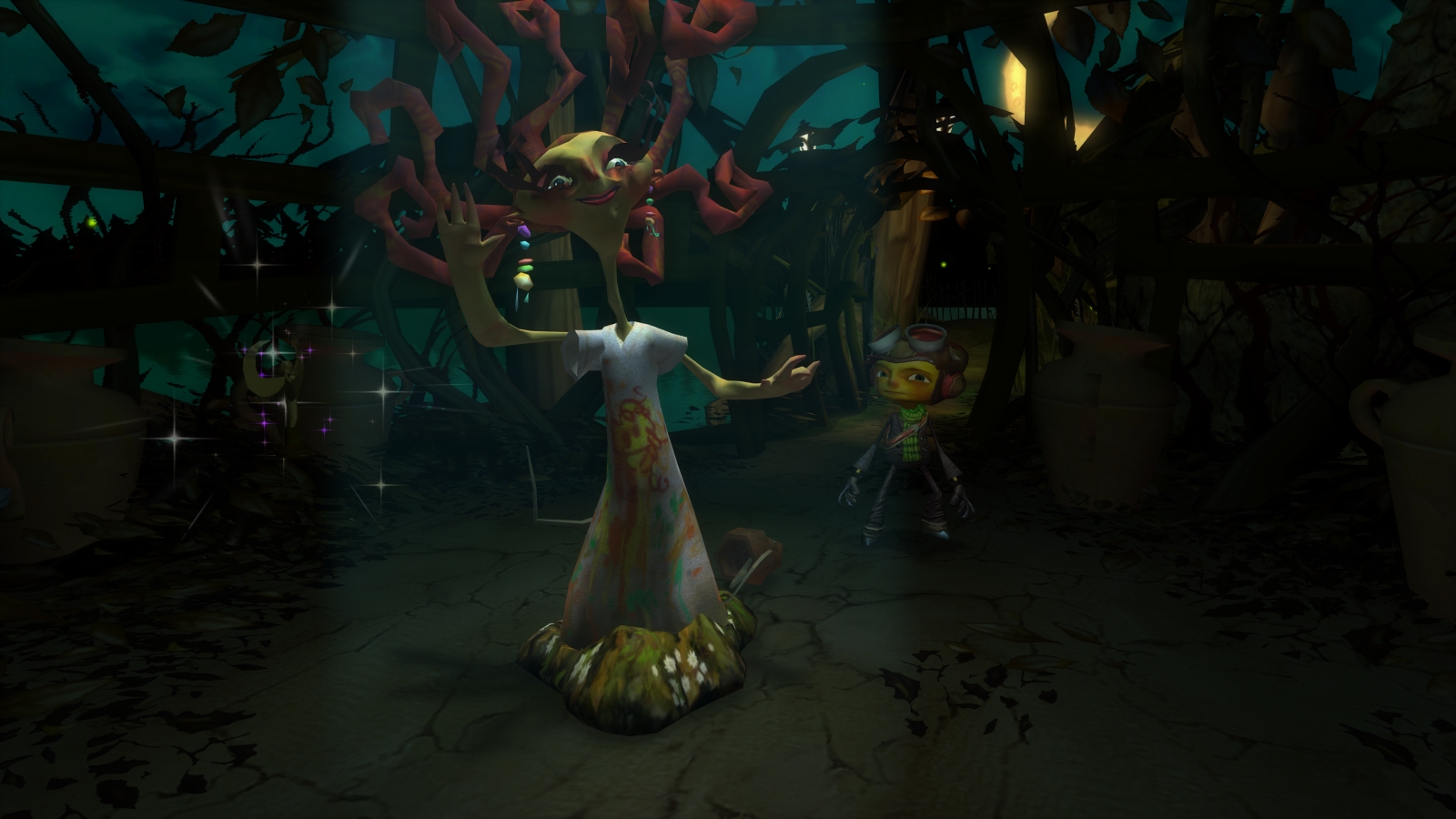
This kicks off my favorite three levels in the game, beginning with Gloria’s Theater. Gloria takes the term “theater of the mind” to a new level, with the level consisting of a literal theater complete with a backstage, catwalks, a stage manager (doing a great job, Becky!), and a critic sitting in his own balcony. Gloria’s inner muse and spirit of her youth, Bonita Soleil, refuses to take the stage because the inner critic has grown loud and cruel, and there’s a mysterious phantom who keeps trying to kill the actors by dropping spotlights on them. Raz can’t do much about the critic, but he can take care of the phantom. The only problem is that there’s no way up to the catwalk, so you need to put on a specific play on a specific stage to get the hot air balloon prop to come down and get on it as it raises back up. It’s a really fun -if brief – set of puzzles where you find the script for a play, put it on, and think about which stage could change the context just enough to reach a new area or unlock something. It’s also an excellent marriage of storytelling and gameplay as each play relates to Gloria’s memories of her being abandoned in an oppressive boarding school for girls that teaches acting, which she never wanted to go into, or her repeated attempts to make her narcissistic mother love her. Eventually, after realizing she can’t make her mom happy, she leaves to pursue her own happiness, only for her mother to commit suicide during her biggest performance out of jealousy. This tragedy caused her to quit her acting career and spiral into a maladaptive obsession with making others happy, something I can personally relate to.
Once you perform the correct play, Raz finally reaches the catwalk which is a fun and lengthy platforming section. Eventually, you find the phantom only to discover that he’s actually the critic in disguise! This leads to what’s probably the most interesting boss fight in the game, where you need to float back up to the catwalks as the critic attacks you, light the spotlights to stun him, and head back down to punch him. It’s a good mix of puzzles, platforming, and combat that the other encounters in the game could have used. All in all, another fantastic level that doesn’t suffer from some of the game’s more common issues. My first time playing I remember being confused by the mood lighting, which drastically changes the atmosphere of a set along with some of the layout, but I had no issues this time around.
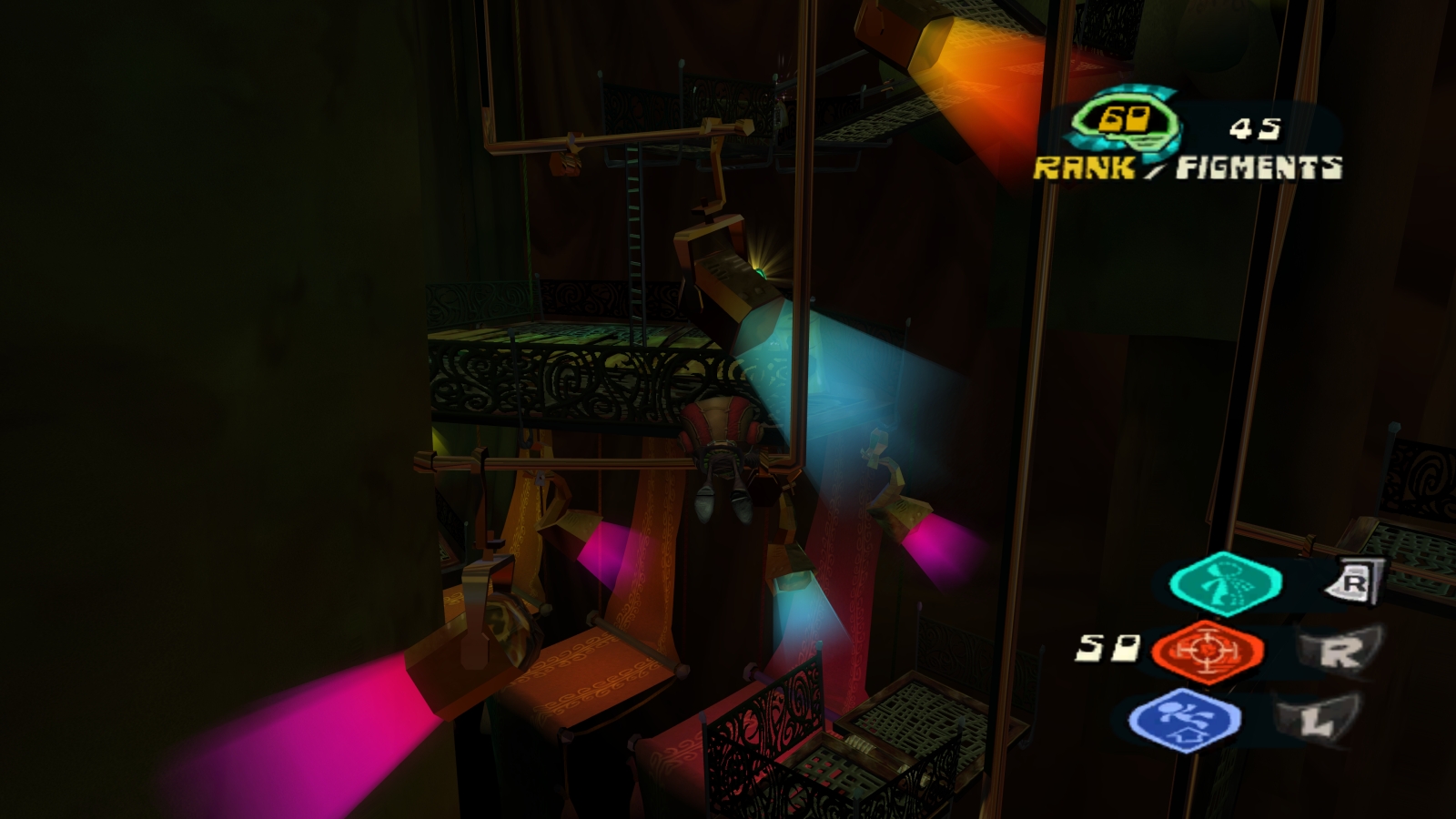
With Gloria now able to confront her issues, Raz is able to proceed into the main building. Dr. Loboto is at the top, but one of his assistants is blocking the elevator. He has bad eyesight though, so if you could put together a makeshift disguise of the doctor he’d let you through. You’ve already got Gloria’s trophy, which looks like a claw arm, so all you need is a straight jacket and something resembling his face. Enter Fred Bonaparte and Edgar Teglee, who owns a straight jacket and is a painter respectively. Of course, they have their own issues you need to solve before they’ll help you, but you can do their levels in any order so let’s start with Fred.
Fred Bonaparte has been haunted by Napoleon Bonaparte ever since the former orderly lost a board game with the guy guarding the elevator. His ancestor now torments him eternally by repeatedly forcing him to repeatedly play the board game in his mind. Needless to say, Fred’s given up at this point and it’s up to Raz to help him finally win for once. While you begin in a small room where the two are playing the game, you can enter the board and tower over the pieces, much like in Lungfishopolis to move things around. At the moment, however, Fred doesn’t have any pieces to move and Napoleon has broken one of the bridges, making crossing the river impossible. To recruit new soldiers, Raz needs to shrink down further and solve the various citizens’ problems, like getting rid of a disturbance on a roof or making escargot for someone. Once a piece is on the field, you can move them with TK to fix bridges, defeat enemy soldiers, and finally take Napoleon’s stronghold. This level is a ton of fun with a great mix of all three styles we’ve seen so far, and the humor is on point too. You swap between all three layers frequently, you can even see the room where Fred and Napoleon are playing when you’re miniature on the board which is trippy, and they make for some fun and creative puzzle solutions. Once you take Napoleon’s fortress (after he cheats, of course), Fred gets his confidence back and you get his straight jacket.
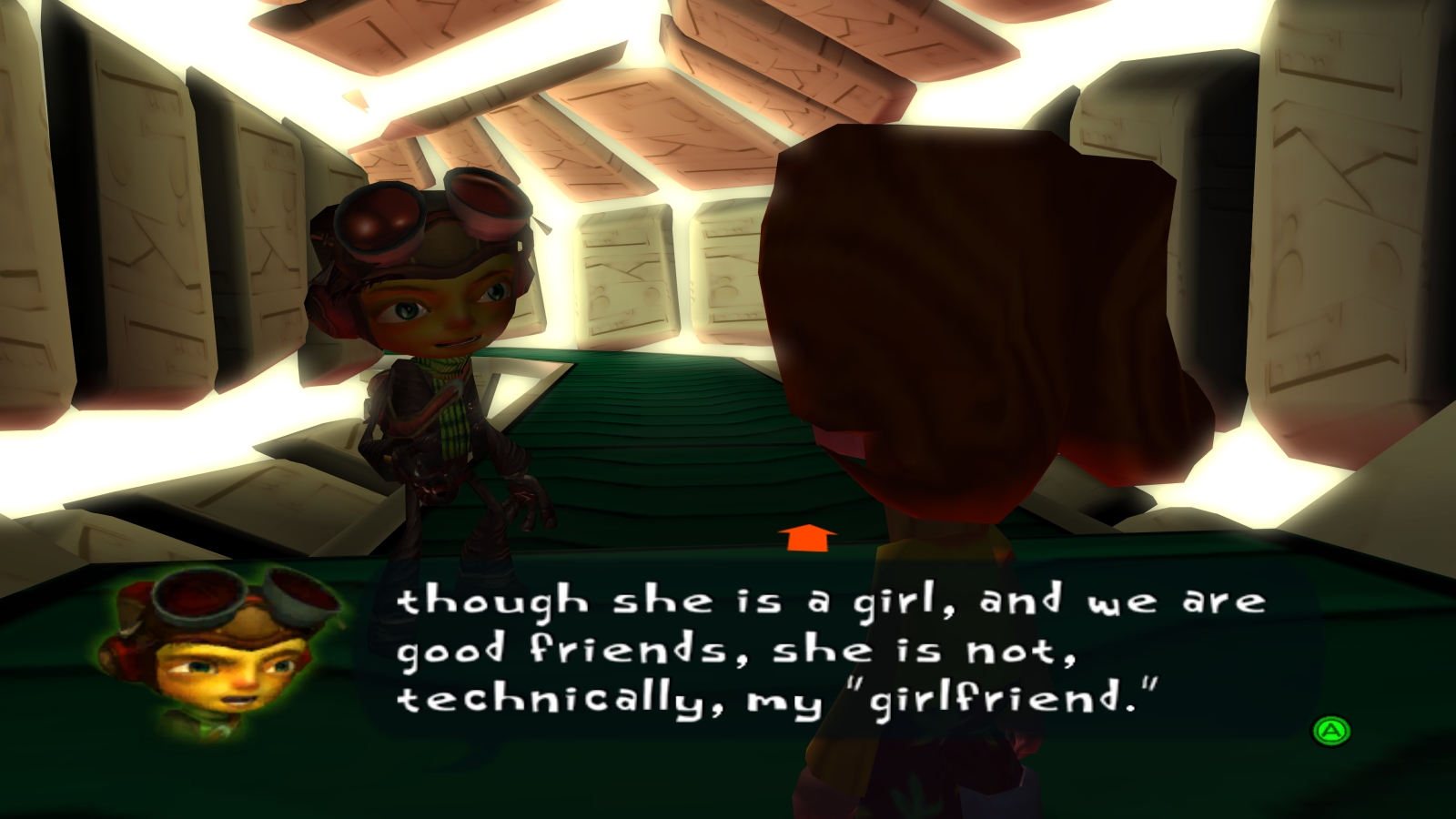
Before we move on to Edgar’s level, I want to touch on the music. While it’s not terribly memorable, it perfectly accentuates every location with cartoony flair. In the asylum’s levels in particular, just like with the level design, they really went all out with the score and it’s just fun to listen to how bonkers it can get. The songs may not stand on their own, but they instead work together with the visuals and gameplay to make the whole stronger than anything individually.
Edgar is free to leave the asylum once he finishes a single painting, but his lingering anger issues make him destroy every canvas after painting a bull and bullfighter over whatever he was painting. He seems like a pretty cool dude otherwise, so Raz enters his mind to help. Black Velvetopia is the most visually striking level of the game with a black and neon aesthetic that even changes Raz’s appearance to match. Edgar is trying to build a tower of cards to reach his love trapped in the sun, but a bull named El Odio keeps knocking it down and stealing the cards. Raz needs to find the four Queen cards in paintings throughout the city while avoiding El Odio charging around street level. This level is another fantastic mix of platforming, puzzle solving, and platforming, where you need to figure out how to reach a certain area by placing paintings that turn into real counterparts to reach new platforms. For example, you can place a guitar painting to serve as a giant ladder or a painting of an archway to make a hole in a wall. Once you reach one of the cards, you need to battle a luchadore with a specific weakness to earn it. To defeat the final one, you need to find the Confusion merit badge, which allows Raz to use the dot in a question mark above his head as a grenade to confuse enemies. It’s a cool power that sadly comes too late in the game to see much use.
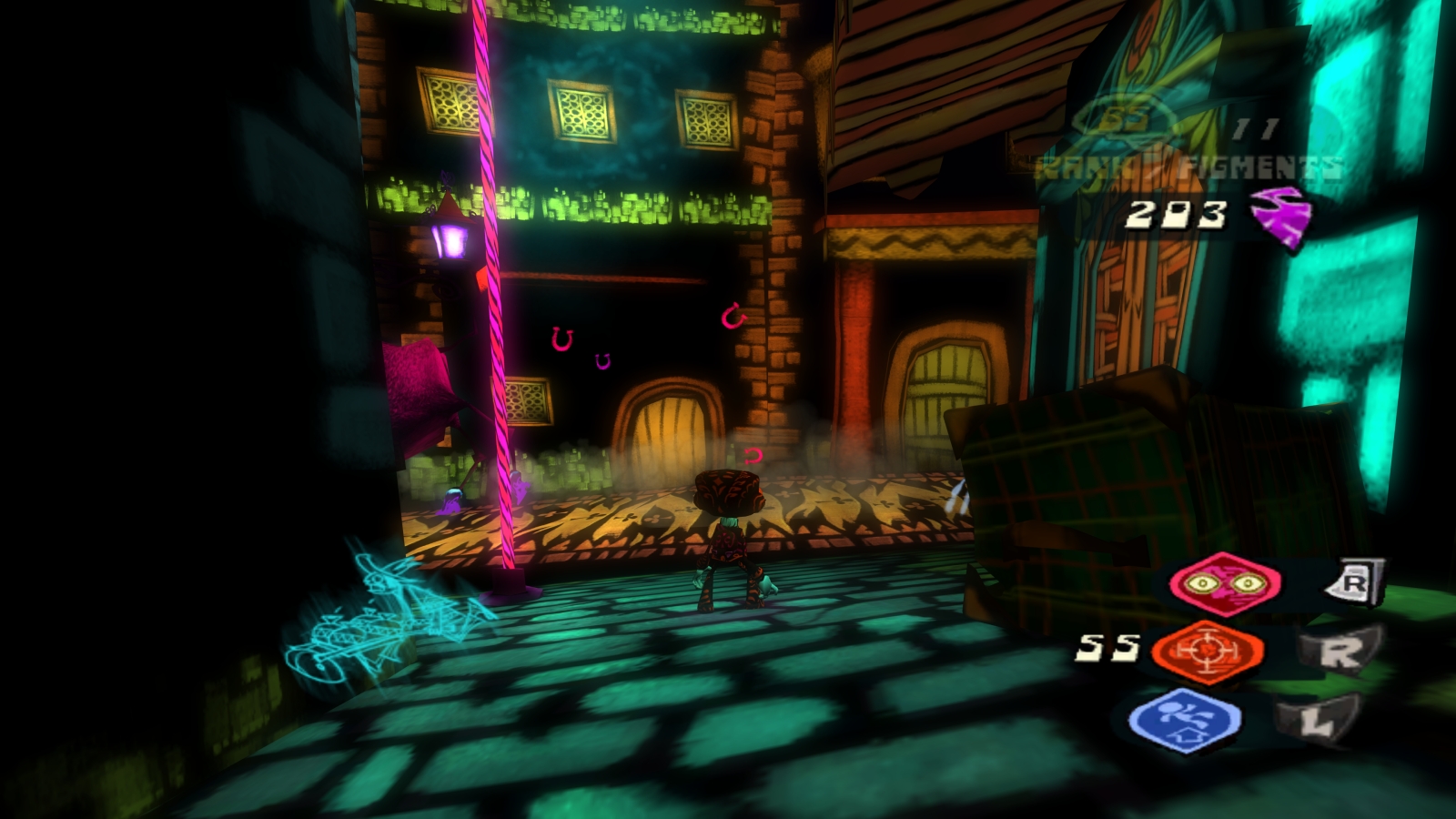
Over the course of the level, it’s hinted that Edgar might not be upset about his wife leaving him for another man, and instead about his high school sweetheart leaving him for another boy. When it’s revealed that Edgar has also been El Odio this whole time, sabotaging himself, Raz needs to show him that, while it’s OK to be upset about it, he shouldn’t still be obsessing over these two shallow idiots. The boss fight begins with you TKing spears into El Odio to stop him, but after the reveal you then throw those spears from the bull to defeat the matador using confusion grenades to make him vulnerable. After he calms down, he realizes that he’s been wallowing in this moment for far too long and finally finishes a painting, this time of Dr. Loboto to use in your disguise. What I really love about these three levels is that, while you do help these individuals through their issues, you don’t just solve them yourself. Instead, you help them get to a point where they can safely tackle their problems knowing that you’re there to support them. It’s a fantastic and positive deception of mental health while still retaining humor and not shying away from some darker themes. We really need more depictions of mental illness like this to normalize it – hopefully Psychonauts 2 can continue to grapple with these themes.
Now it’s time to climb the asylum. This is a straight platforming section in the real world, with only rats who explode in confusion gas to oppose you. It’s a nice break after a series of mental worlds, even if the rats can get really annoying with them reversing your controls and mirroring the world. The jumps you have to make and even just figuring out how to get somewhere can be challenging, especially if you’re trying to find all the kids’ brains which you can recranialize to increase your max health. As you move further upward, a mysterious girl will occasionally appear to scare you away or tell you it’s dangerous to move forward, but regardless Raz continues on and confronts Dr. Loboto…
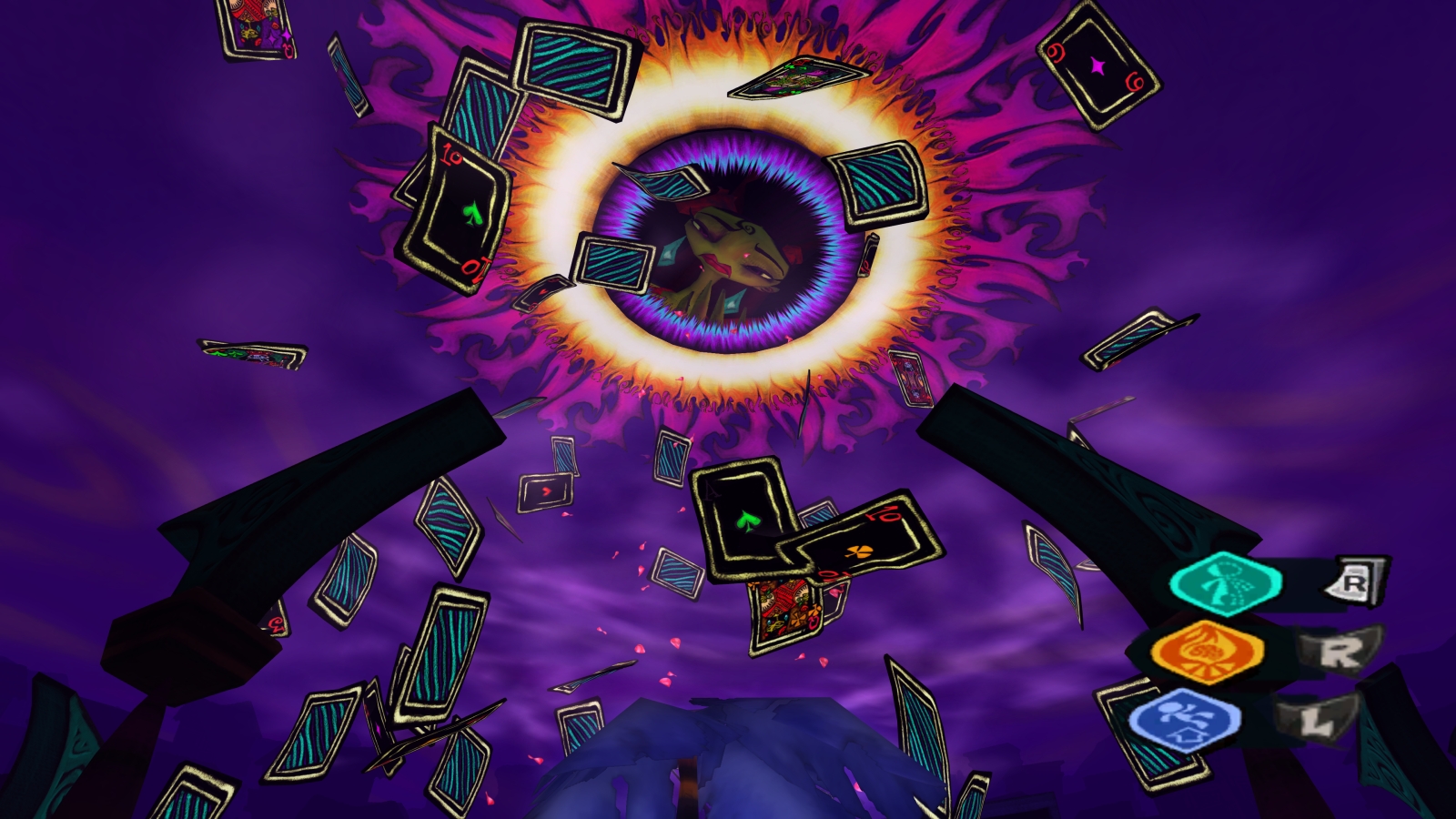
…Who easily captures him within his anti-psychic dome and puts Raz in a waiting room with Lili and an already de-brained Shasha and Mila. The mysterious girl turns out to be Dr. Loboto’s unwilling assistant named Sheegor, who is only helping him because he’s threatening to turn her pet turtle, Mr. Pokeylope, into turtle soup. If Raz can rescue her turtle, she’s sure he can come up with a plan to save everyone as he always tells her what to do. Using a cake, Raz can lure Mr. Pokelyope to a hole in his cage then use Telekinesis to lift him out. After returning the turtle to Sheegor, Mr. Pokeylope describes his plan in a very smooth voice. Sheegor brings the turtle’s brain to Loboto, who places it in his psychic tank prototype. Mr. Pokylope turns the tank’s weapons on the Doctor, sending him flying from the asylum. The group then recranializes Mila and Sasha who together free Lili from her bonds. This is the point of no return, so I hope you’ve collected everything you’ve wanted to by now.
Once Lili is free, Coach Oleander finally reappears. After safely sending Lili and Raz back to the ground, Sasha and Mila defeat the villain in psychic combat. Meanwhile, Gloria, Fred, and Edgar are all preparing to leave when they spot Boyd, still ready to throw his molotov. The three encourage him to leave, so he finally spills his milk and follows them, destroying the asylum. Sasha, Milla, and everyone else thankfully made it out OK, but they once again spot Oleander among the rubble. However, he appears to have been a victim of his own scheme and lost his brain, that is until a finished psychic tank emerges and knocks everyone but Raz unconscious. Fighting the weapon in the real world is very different from the mental world though, it’s much more powerful and has no weak spot on the bottom. The battle revolves around using Telekinesis and Pyrokinisis to remove the barriers Coach surrounds himself with, then throwing some rubble at the glass containing his brain to eventually break it. However, targeting with TK can be annoyingly difficult at times, and once you’ve broken his shields he quickly restores them. It’s not exactly a hard fight in and of itself, what’s hard is getting it to work. Probably one of the game’s lowest points, if not the lowest.
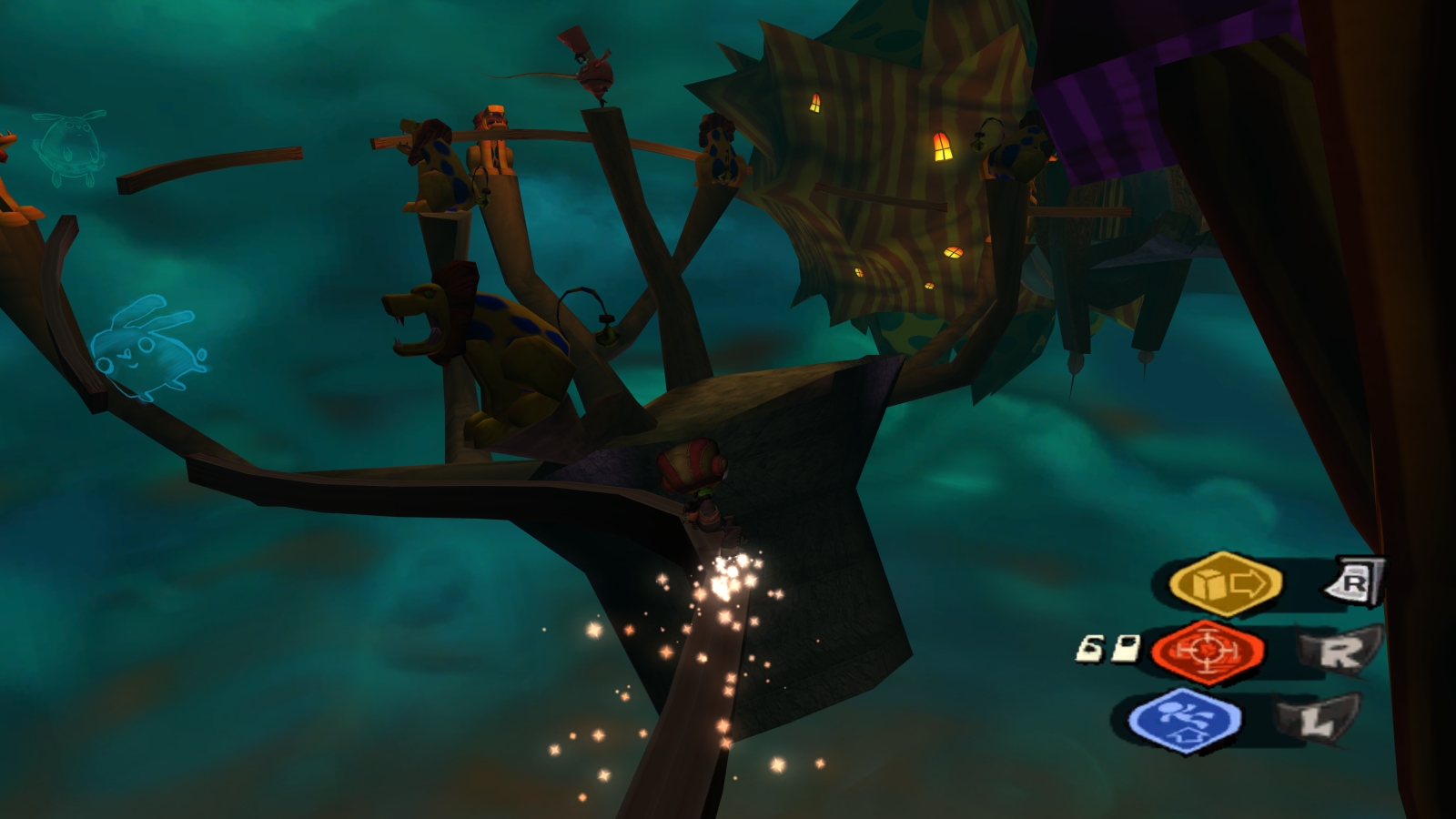
Raz eventually breaks the glass and disables the tank, but Oleander has one more trick up his sleeve: sneezing gas. The same gas that caused everyone to sneeze out their brains, Raz fails to hold it back and his body goes off to mindlessly (pun intended) watch TV. He has no choice but to enter the tank with the Coach’s brain, and the two mental worlds begin to mix. This comes with good news and bad news. The good news is that Raz can help Oleander overcome the childhood trauma that made him evil while confronting his own mental demons in the process. The bad news is that anything that happens to Oleander now also happens to Raz, so he has to protect a childhood version of the Coach while navigating the game’s most infamous and difficult level, the Meat Circus.
The Meat Circus has three phases to it: protecting Oleander, rail grinding and platforming through obstacles, and the final boss. First thing’s first, little Oly is trying to play with the bunnies who his father, as a butcher, thinks are only good for food. This is why Oleander is obsessed with meat and why Raz and Lili have seen visions of meat throughout the game – the Coach has been projecting his thoughts into theirs. To survive this deadly mix of his and Oly’s childhoods, Raz needs to hold the bunnies in place while avoiding monstrous enemies and circus performers so Oly can carry the rabbit to the next section of the level. While this level has been made significantly less difficult in the modern versions of the game, it’s still pretty stressful to need to solve puzzles and jump quickly so Oly doesn’t die before you reach him. Having played the original version of the level, I think this is overall an improvement over the frustrating impossibility of the first releases while still retaining the crazed panic it could induce.
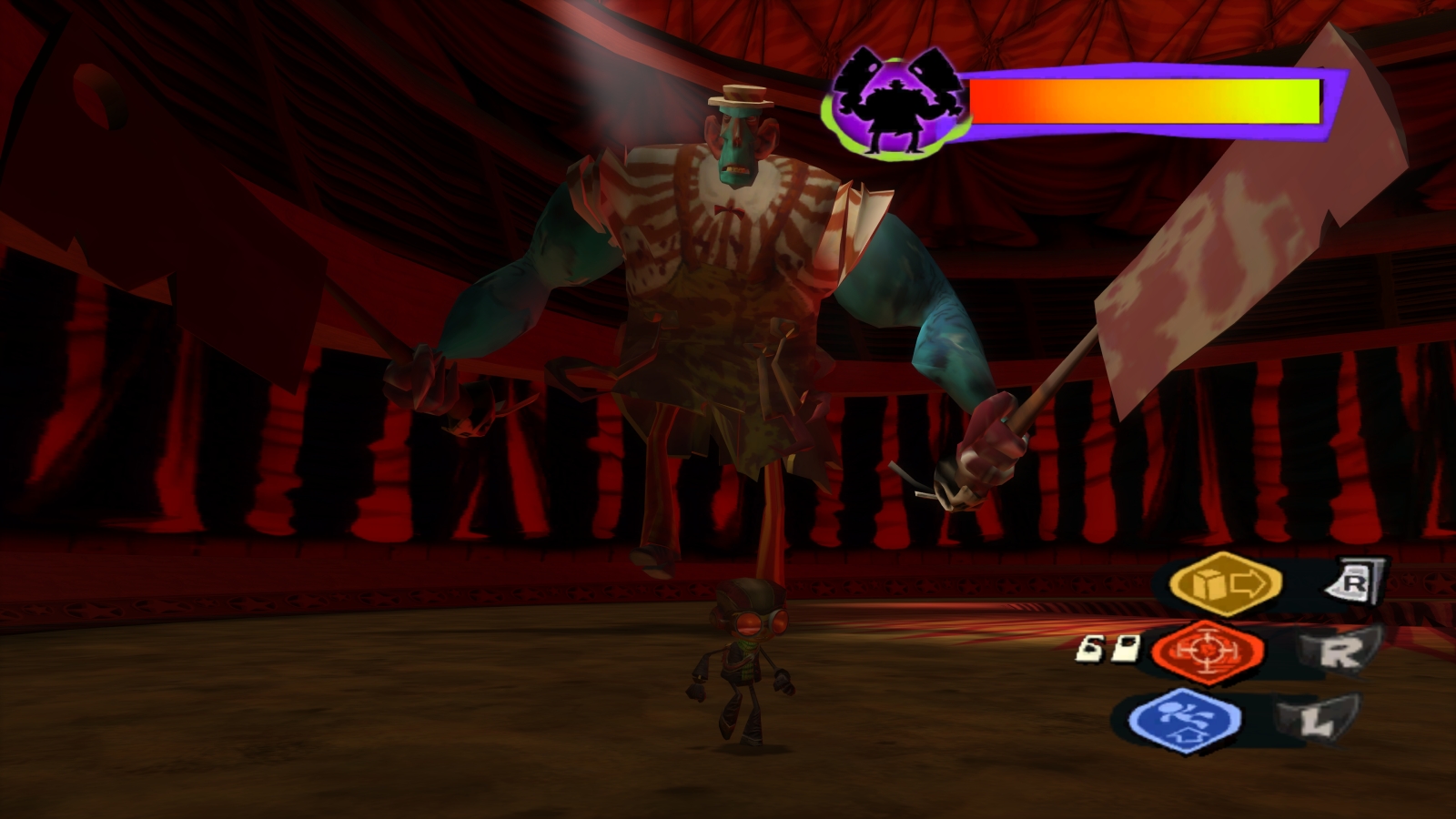
Once you reach the top of the tent, you no longer need to escort Oly. Making your way through the tunnel of love is, again, one of the more difficult grinding sections of the game… considering there were only really two. I only died once here and didn’t try to collect all the figments along the way, so it’s certainly not as hard as the first phase. After the grind, Raz is confronted by Oly’s father – a gigantic, hulking man with two equally big butchers knives. For this fight, you need to wait until he gets his knife stuck in the floor then run up his arm and punch him in his big head. A pretty simple battle, but better than the majority so far.
Once that’s done, Raz is faced with his mental version of his father – a twisted man who hates psychics and seeing his son happy. In a desperate attempt to please him, Raz must make his way through the most difficult, pure platforming section of the game. No distractions here, just you, the trapeze, and the water quickly rising to instantly kill you. The PS2 version of this section was infuriating, so thankfully it’s only mildly intimidating here and serves as a great test of everything you’ve learned along the journey. Raz’s real father then succeeds in entering the kid’s mind and helps his son get rid of the fake. However, the two fake fathers then combine into a giant monstrosity with flaming arms for another boss fight. This time you can’t run up the arms (fire bad) so you need to throw back the explosives the boss drops to get them to fall over and punch them in the head once more. Again, pretty simple but slightly more involved than usual.

Eventually, Raz’s dad lends him his psychic powers to finally defeat the two dads once and for all and separate Raz and Oly’s minds. For a final boss, this is honestly a boring fight. The new power makes Raz big for a short time so he can beat on the fake fathers, and recharges as you run away from their devastating attacks. It doesn’t last very long and health is constantly raining from the sky, so this feels like a victory lap more than anything.
In the end, Raz reconciles with his dad, everyone is saved, and the kids are ready to return home. For his bravery, Raz is immediately made a Psychonaut, just in time too because Lili’s dad, the current head of the organization, has gone missing. Raz, Lili, Sasha, and Mila all set off to rescue him in the jet, and this is where Rhombus of Ruin picks up the plot. I’ll spare you my ramblings on that game (for now…) and end things off here. Psychonauts is a fantastic game that holds up extremely well aside from a few gripes and imperfections, and playing it on Game Pass has made me more excited than ever for the sequel.
Psychonauts
Excellent
Psychonauts is an incredibly unique experience from beginning to end and is worth playing and replaying over and over. It’s heartfelt, hilarious, memorable, and a joy to play.
Pros
- Amazing writing
- Smooth controls
- Excellent art style
Cons
- Boss fights are underwhelming or tedious
- Not optimized for modern hardware
